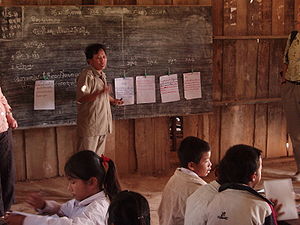 Image via Wikipedia
Image via Wikipedia- perform miracles;
- inspire their students to creative, independent thinking and action that may at times get out of hand; and
- are continually in danger of coming to a sticky end.
A final step was to pull everything together to consider the overall picture, and to choose one of the relationships to think about in more detail, and then write down, or draw that relationship, in particular focussing on what the ideal relationship would be, a lost of barriers to achieving it, and one thing that would affect the relationship for the better.
The audience grouped together to discuss what had been written on the papers, and the noise level went up. As and interesting aside, about 20 people left the room rather than get into groups and discuss the points.
The general buzz, bursts of laughter, and general enthusiasm suggested that the audience relished the opportunity to discuss and exchange ideas around a structure - a set of things that they had been guided to think about, and so felt confident to discuss them. The people who elected to leave I wonder if they are the folk who really dislike group work of this type, and I guess one of the great things of forums like this (as opposed to formal, traditional 'class sessions' is that participants have the freedom to vote with their feet. As such, a session like this does, in effect, fulfil the needs of people present, and those who do not feel comfortable, are empowered to leave.
After the discussions everyone reported back on what they had been talking about. There was a lot of good humour and high energy, and spontaneous feedback about how much everyone enjoyed the activity.
![Reblog this post [with Zemanta]](http://img.zemanta.com/reblog_a.png?x-id=a0cc4b73-8d34-43b3-8f74-fb98477e9e77)





No comments:
Post a Comment